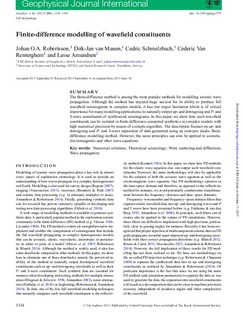| dc.contributor.author | Robertsson, Johan O A | |
| dc.contributor.author | Manen, Dirk-Jan van | |
| dc.contributor.author | Schmelzbach, Cedric | |
| dc.contributor.author | Renterghem, Cederic Van | |
| dc.contributor.author | Amundsen, Lasse | |
| dc.date.accessioned | 2015-11-19T10:12:52Z | |
| dc.date.accessioned | 2016-06-22T08:20:52Z | |
| dc.date.available | 2015-11-19T10:12:52Z | |
| dc.date.available | 2016-06-22T08:20:52Z | |
| dc.date.issued | 2015 | |
| dc.identifier.citation | Geophysical Journal International 2015, 203(2):1334-1342 | nb_NO |
| dc.identifier.issn | 1365-246X | |
| dc.identifier.uri | http://hdl.handle.net/11250/2393514 | |
| dc.description.abstract | The finite-difference method is among the most popular methods for modelling seismic wave
propagation. Although the method has enjoyed huge success for its ability to produce full
wavefield seismograms in complex models, it has one major limitation which is of critical
importance for many modelling applications; to naturally output up- and downgoing and P- and
S-wave constituents of synthesized seismograms. In this paper, we show how such wavefield
constituents can be isolated in finite-difference-computed synthetics in complex models with
high numerical precision by means of a simple algorithm. The description focuses on up- and
downgoing and P- and S-wave separation of data generated using an isotropic elastic finitedifference
modelling method. However, the same principles can also be applied to acoustic,
electromagnetic and other wave equations. | nb_NO |
| dc.language.iso | eng | nb_NO |
| dc.publisher | Oxford University Press | nb_NO |
| dc.title | Finite-difference modelling of wavefield constituents | nb_NO |
| dc.type | Journal article | nb_NO |
| dc.type | Peer reviewed | nb_NO |
| dc.date.updated | 2015-11-19T10:12:52Z | |
| dc.source.volume | 203 | nb_NO |
| dc.source.journal | Geophysical Journal International | nb_NO |
| dc.source.issue | 2 | nb_NO |
| dc.identifier.doi | 10.1093/gji/ggv379 | |
| dc.identifier.cristin | 1290823 | |
| dc.description.localcode | © The Authors 2015. Published by Oxford University Press on behalf of The Royal Astronomical Society. | nb_NO |
